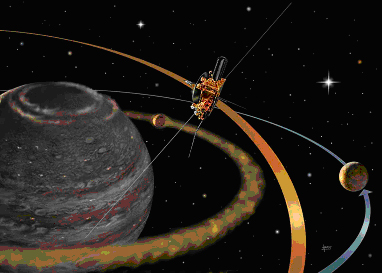Gravity Assist
While we are able to place satellites into a polar orbit around the Earth without much difficulty, the energy needed to launch a space probe into a polar orbit around the Sun is far greater. So much energy is required in fact, that even with the powerful launch vehicles available today, direct injection from the Earth cannot be achieved. This is because the Earth itself orbits the Sun at a speed of 30 km/s in a plane perpendicular to the desired solar polar orbit. The energy imparted to a space probe must cancel out this motion in addition to providing the correct polar trajectory.
A polar orbit can be achieved, however, by taking advantage of a so-called "gravity assist" by another planet. In the case of Ulysses, Jupiter was the nearest planetary body capable of meeting the requirements.
The way a gravity assist manoeuvre works has to do with the relative velocities of the spacecraft and of the planet involved, and the law of conservation of angular momentum. The spacecraft approaches the planet, and because the planet is moving too (while orbiting the Sun), it actually transfers some of its angular momentum to the spacecraft. What the space probe gains in velocity, the planet loses. Because the mass of the planet is huge compared with that of the spacecraft, the loss is imperceptible.
Even with this gravity assist, the combined power of the space shuttle and three upper-stage rockets were needed to send the 370 kg Ulysses space probe on its way. As it left the confines of the Earth's gravitational field, Ulysses was travelling at 11.3 km/s, making it the fastest interplanetary spacecraft ever launched.
 |
